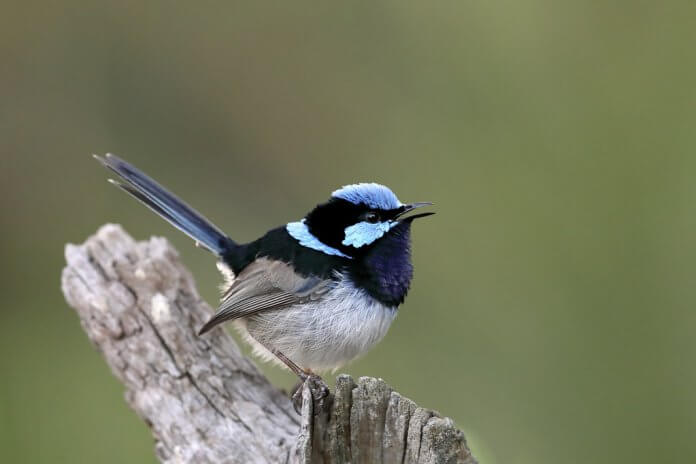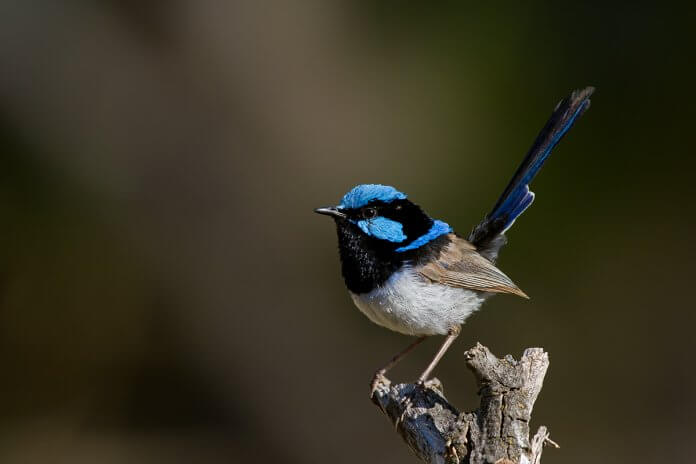Page Contents
Description:
The Superb Fairy-wren is a lovely cocked tail, iridescent blue plumage, and boldness in adapting to urbanization, parks, and gardens. Its vibrant colors have made the Superb Fairy-wren one of the most popular and familiar of Australia’s birds. This is a passerine bird in the Australasian wren family, Maluridae. This bird is particularly known for many peculiar behavioral characteristics.
Superb Fairy-wrens are sedentary and territorial birds, remaining paired in a close-knit group year-round. Out of breeding, they wander beyond territorial boundaries, but rarely far. Among the first birds to call in the morning, males begin to sing before daylight, and then, soon after dawn, the groups begin foraging.
Habitats:
In shrubberies of open forest and woodland around the southeast. These Fairy-wrens are socially monogamous and sexually promiscuous. It lives in family groups comprising the adult pair, their young of the year, and often several additional males.
The preponderance of brown birds in such groups gave rise to the idea that each blue-colored male maintained a ‘harem’. Most brown birds, however, are junior males which moult into female-like plumage at the end of summer and back into a blue nuptial dress at the start of spring breeding. They nonetheless retain their black bills and dusky lores through winter.
Only old males over four or five years old may moult directly from one nuptial plumage to another. It is they who tolerate other males in the group, while the parental female drives off members of her own sex.

Diet:
They hop and flit along, tails cocked and bouncing, pecking here and there for food: a wide range of small insects, such as flies, grasshoppers, ants, caterpillars, bugs, supplements seeds, flowers, and occasionally fruit lets. During the middle hours, they divert to resting and mutual preening, the whole group perching side by side, one preening another and leapfrogging into the huddle to do so.
After another round of feeding later in the afternoon, the group goes to roost on set horizontal perches in tall shrubbery, again huddling together side by side to sleep. In winter, the food is a bit short, they are mostly relying on ant feeding.
Breeding:
The breeding season is August-March, however rarely after January. It is occasionally in other months in the drier areas following substantial rain. Therefore, with the help of additional members, pairs of fairy-wrens regularly raise two or three broods a season, and sometimes even four.
All members bring food to the nestlings as they grow, and when they fledge the dominant male and the unattached adults take over their care, leaving the female free to nest again. In their first week out, the fledglings can barely fly and stay hiding, camouflaged in deep shrubbery. Gradually they begin to follow adults and learn to feed, becoming independent in three to four weeks and later returning to help feed the next brood.
Despite this fecund reproduction, misadventure and predation take their toll, and less than half of each season young reach independence. Normally, the clutch contains three or four eggs, that is white, spotted with red-brown at the larger end; oblong-Oval, about 17 x 12 mm. Incubation period is about 13-15 days, by a female. Usually, the chick fledges in 13-14 days.

Identification:
The average male bird length is about 120-150 mm. The Male bird in breeding plumage, crown, and upper back is sky-blue. Back of neck-through eye to lores, scapular, and lower back black. The wings are gray-brown; however, the tail is dark blue with narrow white tips.
There is a cheek patch oval shape, sky-blue. The throat and breast are blue-blacks, and the rest of the underparts are white. The eyes are dark brown with a black bill. Feet are normally flesh-gray. In non-breeding plumage, upperparts are mid-grey-brown; lores and area around the eye are dusky; while the underparts are grayish-white.
The Female bird is a male in non-breeding plumage: tail browner with greenwash bill and feet. Also, the area around the eye is orange-brown. The immature for the first few months resembled females, except for the browner tail. In autumn young males gain blue tails and, in the following spring, full breeding plumage.
Song/Call/Sounds/Vocals
Song battles between neighbors are common. Areas occupied by each group may vary from about half to two hectares. Virtually all the male’s displays are directed aggressively to territorial defense: song from vantage perches, flattened and spread plumage with flared ear coverts, and chasing.
Superb Fairy-wren call is staccato prip-prip or downwards trill in contact, repeated; high-pitched reed-like seeee and churring in alarm; also brooding purr by a female. The Superb Fairy-wren song is a bit loud, with rich rippling warble, descending in pitch, and introduced by several chirps. By both sexes to advertise territory and keep the group together.

Nest:
The female alone builds the nest, incubates, and broods the hatchlings in their first few days, and she feeds herself as well. Nest building with a small loose grass ball with a side entrance, about 80-120 mm wide. The grass stems and blades weaved into the framework of cobwebs; lined with finer grasses and feathers. Thus, usually in dense bush or tussock up to one meter above the ground, occasionally much higher.
Nest building usually takes several days, and she may let it lie fallow for a week or more before laying, at 24-hour intervals in the morning, until the clutch is complete. The male stands sentry near the nest, escorts the female on her foraging, and sings constantly to advertise territory.

Distribution:
Superb Fairy Wren is common and familiar across SE Australia. These are well adapted to the urban environment, one can easily find, this wren’s in the dense undergrowth grasslands with scattered shrubs, woodlands, heaths, moderately thick forests, and gardens. Highland southeastern Queensland to Tasmania and the southern Eyre Peninsula, SA, Kangaroo Island. Generally, within 200 km of the coast, but also along with Murray and Lachlan river systems.
Courtship:
There is no obviously ritualized courtship, copulation following perfunctorily after a bout of chasing, or mutual preening. Males, apparently in courtship, sometimes carry colored petals.
Other Names:
Superb Blue Wren, Blue Bonnet, Fairy Wren, Mormon Wren.
Read About – The Wedge-tailed hillstar (Oreotrochilus adela)
